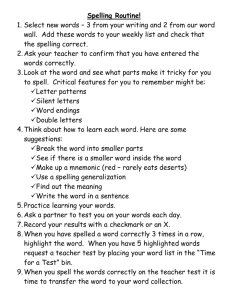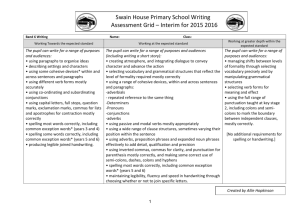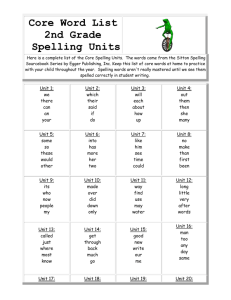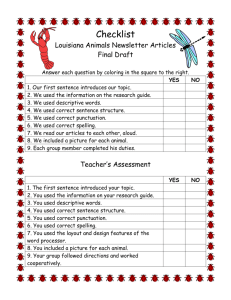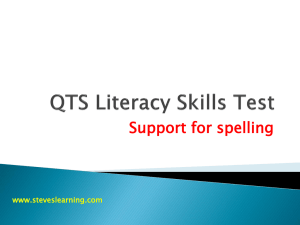Parents' forum Jan 2016
advertisement
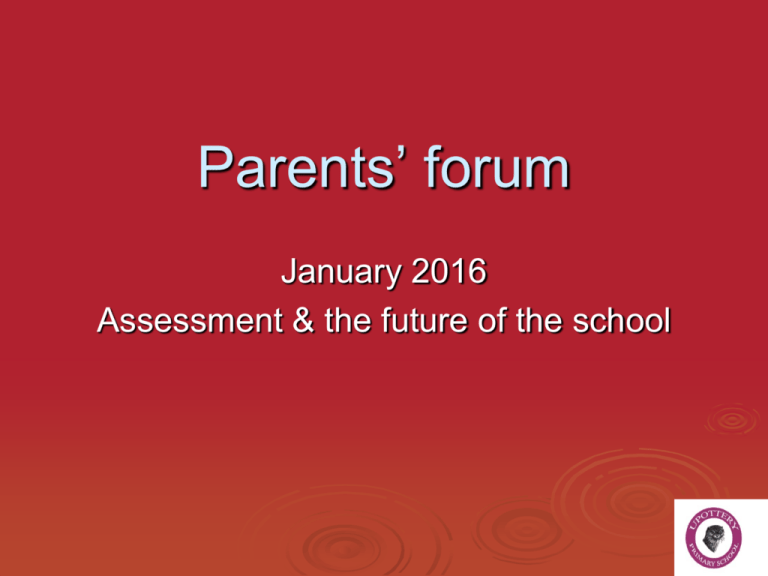
Parents’ forum January 2016 Assessment & the future of the school School news World culture week (WB 8th Feb) New synthetic phonics reading books soon Open afternoon- 28th January Y5/6 Houses of Parliament trip- 4th July Redecoration of Falcon classroom Looking at ways to improve the playground. KS2 SATs 2015- local schools Forum focus: Assessment Key questions Why has this change happened? Which children in school are affected? What will replace the levels? What is mastery? What is assessment? Schools are expected to demonstrate their assessment of pupils’ attainment and progress and share this with parents. At Upottery, we have continued to assess attainment and progress through: Observations of the children learning Looking at learning in the children’s books Talking with the children about their learning Formal assessments of learning The new curriculum encourages teachers and children to look at what the children can do and what the children need to do next, identifying strengths and areas for development. Why has this change happened? “… the current system of levels and level descriptions will be removed and not replaced.” Department for Education (July 2013) “Schools need to be conscious that the new curriculum is not in alignment with the old national curriculum levels.” NAHT commission on assessment (February 2014) A new national curriculum was introduced in September 2014. The new curriculum is more challenging therefore expectations are higher. The government have removed levels and are leaving it up to individual schools to design their own individual framework. Which children are affected? Children in Foundation Stage are not affected by these changes. From September 2015, all children from Y1 to Y6 have been assessed using a new system based on Age Related Expectations (ARE). What will replace levels? The Curriculum has been split up in to Schemes of Work. Each scheme of work sets out the objectives which must be achieved at each year group. Teachers at Upottery assess which objectives each child has grasped and which objectives they still need to master. What will replace levels? Cont. With the changes to the National Curriculum, expectations at each year group have changed. Children are expected to be working at a higher level. Objectives have moved to younger year groups. Due to this, many children are currently learning objectives which are in a lower year group to that of their age. Spellings in particular are an issue… What is mastery? The new National Curriculum is called a Mastery Curriculum. Teachers have to teach the objectives of the year group. If your child is achieving well and has achieved the objectives for their year group, rather than moving on to the following year group’s objectives, we have to encourage more in-depth and investigative work to allow a greater mastery and understanding of concepts and ideas. If a child can demonstrate a comprehensive and broad application of their understanding (a mastery), then we are able to push them in to the objectives of the next year, although this is a very small number. How does this affect Key Stage 1 and Key Stage 2 SATs? Statutory assessment in Year 2 and Year 6 continue but no levels given. A scaled score will be given. “…100 will always represent the ‘national standard’” Department for Education (June 2015) No information has been given for what is above and below average (see quote below). “We do know the scale will have a lower end point below 100 and an upper end point above 100. Once we have set the national standard we will use a statistical technique called ‘scaling’ to transform the raw score into a scaled score. We will publish this after the first tests have been administered.” Department for Education (June 2015) Children in years 1, 3, 4 and 5 will set end-of-year tests much like the old optional SATs. However, these are not DfE approved. Key Stage 1 SATs Tests in Reading, Maths and Spelling, Punctuation & Grammar (SPAG) As in the past, tests inform teacher assessment (TA)- the TA is the reported level. For writing the DfE have published an interim criteria. KS1 writing criteria Working at the expected standard The pupil can write a narrative about their own and others’ experiences (real and fictional), after discussion with the teacher: demarcating most sentences with capital letters and full stops and with some use of question marks and exclamation marks using sentences with different forms in their writing (statements, questions, exclamations and commands) using some expanded noun phrases to describe and specify using present and past tense mostly correctly and consistently using co-ordination (or / and / but) and some subordination (when / if / that / because) segmenting spoken words into phonemes and representing these by graphemes, spelling many correctly spelling many common exception words* spelling some words with contracted forms* adding suffixes to spell some words correctly in their writing e.g. –ment, –ness, –ful, –less, –using the diagonal and horizontal strokes needed to join letters in some of their writing writing capital letters and digits of the correct size, orientation and relationship to one another and to lower case letters using spacing between words that reflects the size of the letters. ALL criteria with the exception of handwriting must be met! Working at greater depth within the expected standard The pupil can write for different purposes, after discussion with the teacher: using the full range of punctuation taught at key stage 1 mostly correctly spelling most common exception words* spelling most words with contracted forms* adding suffixes to spell most words correctly in their writing, e.g. –ment, –ness, –ful, –less, –ly* using the diagonal and horizontal strokes needed to join letters in most of their writing. + ALL the criteria for the expected standard INCLUDING handwriting. KS2 writing criteria Working at the expected standard The pupil can write for a range of purposes and audiences creating atmosphere, and integrating dialogue to convey character and advance the action selecting vocabulary and grammatical structures that reflect the level of formality required mostly correctly using a range of cohesive devices*, including adverbials, within and across sentences and paragraphs using passive and modal verbs mostly appropriately using a wide range of clause structures, sometimes varying their position within the sentence using adverbs, preposition phrases and expanded noun phrases effectively to add detail, qualification and precision using inverted commas, commas for clarity, and punctuation for parenthesis mostly correctly, and making some correct use of semi-colons, dashes, colons and hyphens spelling most words correctly* (years 5 and 6) maintaining legibility, fluency and speed in handwriting through choosing whether or not to join specific letters. ALL criteria with the exception of handwriting must be met! KS2 writing criteria Working at greater depth within the expected standard. The pupil can write for a range of purposes and audiences: managing shifts between levels of formality through selecting vocabulary precisely and by manipulating grammatical structures selecting verb forms for meaning and effect using the full range of punctuation taught at key stage 2, including colons and semi-colons to mark the boundary between independent clauses, mostly correctly. + ALL the criteria for the expected standard INCLUDING handwriting. Above all… Do not worry! This is a positive move for children and their learning. This will take time. Any questions about assessment? Future of the school Budgetary issues (not specific to Upottery). Changes in assessment will affect data- not comparable. Ensuring the current size of the school is maintained. Front playground/ grounds. David Cameron announced in August 2015 that he wants all school to become academies. These are now all in the form of multi- academy trusts (MATs). School dinners Thursday January st 21
